BCP services also include ongoing maintenance and testing of the continuity plan. This ensures that the plan remains up-to-date and relevant as the organization’s operations evolve and that the plan can be executed effectively in the event of a disruption. Testing may involve tabletop exercises, simulation drills, or full-scale tests of the continuity plan.
Finally, BCP service providers may also offer training and education to the organization’s employees. This helps to ensure that everyone is familiar with the continuity plan, understands their role in implementing it, and can respond effectively in the event of a disruption.
Overall, BCP services are essential for any organization that wants to ensure that its operations can continue in the event of a disruptive event. By working with a BCP service provider, organizations can develop a comprehensive plan that addresses potential risks, identifies critical functions, and establishes procedures for responding to a disruption. This helps to minimize the impact of a disruption on the organization’s operations and enables them to recover more quickly.
Disaster recovery IT services are designed to help organizations recover from IT-related disruptions that could impact their operations. These disruptions can include cyber attacks, natural disasters, power outages, hardware failures, and software malfunctions. IT service providers offer a range of disaster recovery services, from backup and recovery solutions to full-scale disaster recovery planning and implementation.
One of the key components of disaster recovery IT services include data backup and recovery. This involves regularly backing up an organization’s critical data to an offsite location, ensuring that data is available in the event of a disruption. IT service providers may use a range of backup technologies, such as cloud-based backup solutions or tape backup, depending on the organization’s needs and budget.
Another important component of disaster recovery IT services include disaster recovery planning. This involves working with the organization to identify potential risks and vulnerabilities, developing a plan to respond to a disruption, and implementing a solution to restore IT operations as quickly as possible. Disaster recovery planning may involve developing redundant systems or establishing failover mechanisms to ensure that critical IT functions can continue even if one system fails.
IT service providers also offer testing and maintenance of disaster recovery solutions. This ensures that the disaster recovery plan remains up-to-date and effective and that the organization’s IT systems can be restored quickly and efficiently in the event of a disruption. Testing may involve running simulation drills or full-scale tests of the disaster recovery plan.
Finally, disaster recovery IT services may also include training and education for the organization’s employees. This helps to ensure that everyone is familiar with the disaster recovery plan, understands their role in implementing it, and can respond effectively in the event of a disruption.
Overall, disaster recovery IT services are critical for any organization that relies on IT systems to conduct its business. By working with an IT service provider, organizations can develop a comprehensive disaster recovery plan that addresses potential risks, establishes procedures for responding to a disruption, and ensures that critical IT functions can continue in the event of a disruption. This helps to minimize the impact of a disruption on the organization’s operations and enables them to recover more quickly.
Business continuity planning (BCP) and disaster recovery planning (DRP) are both essential components of any organization’s risk management strategy. BCP refers to a proactive process of identifying potential risks to an organization’s operations and developing strategies to ensure continuity of essential functions in the face of a disruption. DRP, on the other hand, is a reactive process focused on restoring critical systems and infrastructure after a disaster or disruptive event.
To effectively combine BCP and DRP, it’s important to first understand the unique goals and objectives of each process. BCP is focused on minimizing the impact of a disruption on the organization, while DRP is focused on recovering from the disruption as quickly as possible. Therefore, a comprehensive approach to risk management should involve both proactive and reactive measures.
One way to combine BCP and DRP is to develop a comprehensive business continuity and disaster recovery plan that includes both proactive and reactive strategies. This plan should outline the steps to be taken in the event of a disruption, including communication protocols, data backup and recovery strategies, and alternative work arrangements. It should also identify potential risks to the organization’s operations and develop strategies to mitigate those risks before they can cause a disruption.
Ultimately, by combining BCP and DRP, organizations can develop a more comprehensive and effective risk management strategy that ensures continuity of essential functions and quick recovery from any disruptions.


